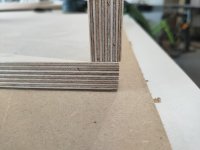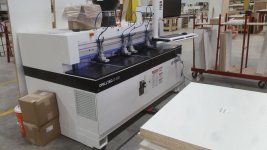First thing to say is I'm a bit of a novice and just wanted some thoughts on where I'm going wrong. Had the DF500 for about a year and the first project I did with it was a large bookcase, which went really well - all butt joints were lovely and flush. Absolutely delighted with the final outcome.
Since then, I hadn't used it for a while but came back to it recently to build a few more small media units for TV/AV equipment etc. I've done 3 of them now, and on each one I'm having trouble getting a flush butt joint on some of the corners. I'm getting anywhere from 0.5mm-1.5mm out on the join - I've attached a couple of photos that should show what I mean. I know the middle of the mortice should be 10mm up from the bottom/edge of the board but I'm getting anywhere between 9mm-10.5mm at times.
So where am I going wrong? I'm sure the tool is set up correctly. I take my time on these mortices as I know if you go too quick, you can get tear out etc. I make sure I've set the right width, depth etc on each one until I get more practice at it.
I'm working on a flat level surface. The only thing I can think is that a bit of sawdust has got under the workpiece or the bed of the DF500, raising either of them up by a mm or so to create this indiscretion. Thoughts?
Since then, I hadn't used it for a while but came back to it recently to build a few more small media units for TV/AV equipment etc. I've done 3 of them now, and on each one I'm having trouble getting a flush butt joint on some of the corners. I'm getting anywhere from 0.5mm-1.5mm out on the join - I've attached a couple of photos that should show what I mean. I know the middle of the mortice should be 10mm up from the bottom/edge of the board but I'm getting anywhere between 9mm-10.5mm at times.
So where am I going wrong? I'm sure the tool is set up correctly. I take my time on these mortices as I know if you go too quick, you can get tear out etc. I make sure I've set the right width, depth etc on each one until I get more practice at it.
I'm working on a flat level surface. The only thing I can think is that a bit of sawdust has got under the workpiece or the bed of the DF500, raising either of them up by a mm or so to create this indiscretion. Thoughts?




